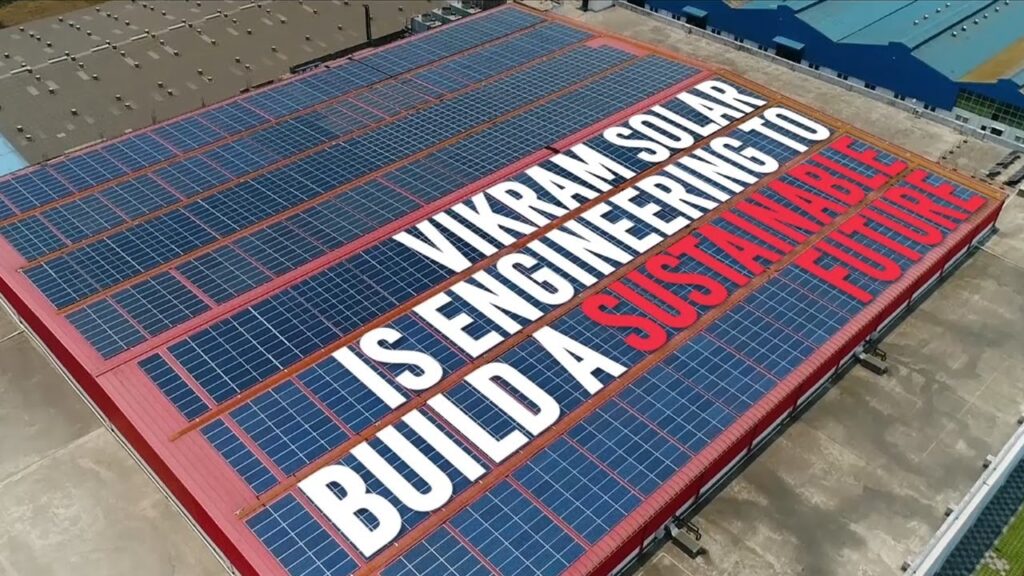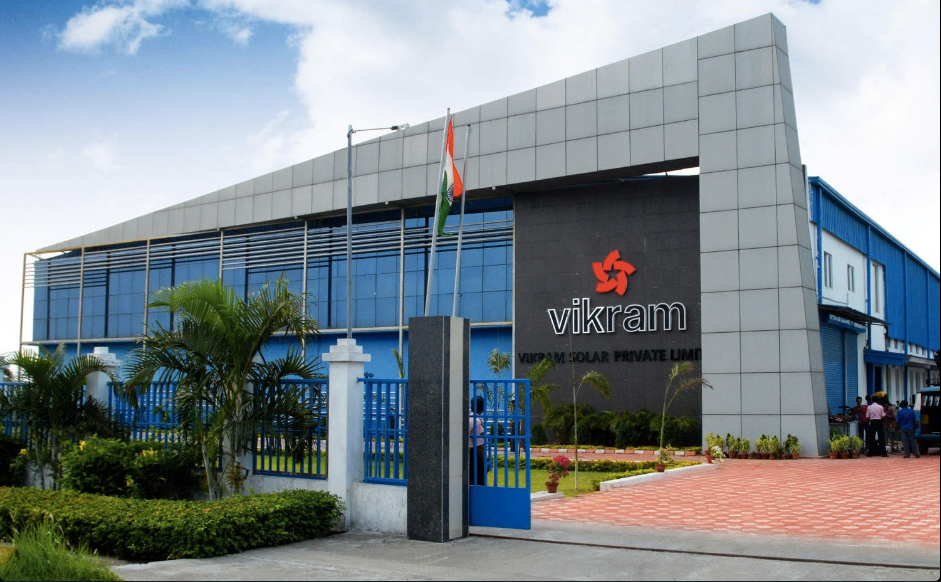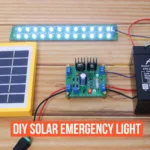Introduction
Vikram Solar is one of India’s leading solar panel manufacturers. Their solar modules power homes, industries, and large solar farms across the country. In this review, we look closely at how Vikram Solar panels perform in real Indian conditions. We study their efficiency, durability, warranties, performance under heat and dust, cost, and more. We also add answers to common questions Indian buyers often ask.
1. Company and Product Overview

- About Vikram Solar:
Based in West Bengal, Vikram Solar has over a decade in solar manufacturing. They make monocrystalline and PERC solar modules. Their products are used from rooftop installations to mega solar farms. - Product Range:
They offer panels in the 325 W to 440 W range. Most are monocrystalline with PERC tech. Higher efficiency panels are in the 20%–21% range.
2. Efficiency: How Much Power They Generate
- Rated Efficiency:
Vikram panels typically offer efficiency between 19% and 21%. This efficiency is in lab conditions (STC). It is very good among Indian brands. - Real‑world Efficiency:
Under Indian sun and heat, real efficiency drops by 5%–10%. But Vikram’s PERC modules still perform better than many older polycrystalline ones.
Also Read gst rate solar panels india 2025
3. Heat Resistance and Performance in High Temperatures
- Why Heat Matters:
Indian summers often cross 40 °C. Solar panels lose some power when it’s hot. - Vikram’s Temperature Coefficient:
Their panels have a temperature coefficient around –0.35%/°C. This is slightly better than older panels at –0.45%/°C. So, Vikram panels lose less power in heat. This matters a lot in India.
4. Dust, Soiling, and Weather Durability
- Dust and Soil:
Many regions in India are dusty. Panels get soiled and lose efficiency. - Build Quality:
Vikram panels use anti-reflective coating and smooth glass. This helps dust slide off. But routine cleaning is still needed, especially in dusty areas. - Protected Against Environment:
Their panels have 1500 V bifacial double-glass design (for some models). They are strong against humidity. They also pass hail impact and salt mist tests.
5. Durability & Long-Term Performance
- Degradation Rate:
Industry standard degradation is 0.7–0.8% per year. Vikram claims slower degradation of about 0.55–0.6% per year. That leads to better output over 25 years. - Warranty:
They provide a 12‑year product warranty and 25‑year performance warranty (minimum 87% power by year 25). This matches top-tier global brands.
6. Suitability for Different Indian Climates
- Hot and Dry Areas (e.g., Rajasthan):
Strong heating but low humidity. Vikram panels handle heat well. Dust needs cleaning though. - Coastal Areas (e.g., Tamil Nadu, Gujarat):
High salt and humidity. Double-glass and salt-spray resilience helps. - Cold / Monsoon Regions (e.g., Himachal, Northeast):
Lower temperature improves efficiency. Tough build resists rains and snow.
7. Field Performance & Case Studies
- Large-Scale Projects:
Vikram Solar supplies panels to solar parks. Reports show consistent output and low failure rates. - Residential Use:
Rooftop users report monthly generation close to estimates. After one year, many saw 3%–5% loss due to dust not panel defect. - User Sentiments:
Homeowners appreciate strong warranties and support. After-sales service variable by region. In metro areas like Bengaluru or Delhi, service is prompt.
8. Comparison with Other Major Brands
| Feature | Vikram Solar | Other Indian Brands | Global Tier-1 Panels |
|---|---|---|---|
| Efficiency | 19%–21% | 16%–19% | 20%–22% |
| Temp Coeff. | –0.35 %/°C | –0.40 %/°C to –0.45 %/°C | –0.30 %/°C to –0.35 %/°C |
| Degradation Rate | ~0.55%/year | 0.7%–0.8%/year | 0.45%–0.55%/year |
| Warranty | 12 yr product, 25 yr performance | 10–12 yr product, 20–25 yr perf. | 12 yr product, 25 yr perf. |
| Price | Competitive (₹18–22/W) | Often cheaper, €0.1–0.2/W less | Higher by 10–20% |
| Durability | Very good – double glass, anti-soil | Varies widely | Excellent, tested globally |
9. Economic Value & Return on Investment (ROI)
- Upward Cost:
Vikram panels cost slightly more than generic modules. But they are cheaper than Tier‑1 global brands. - Energy Yield:
Better heat resistance and lower degradation mean more energy over time. - Return Payback:
In sunny, dusty regions, users say the system pays back cost in 3–5 years. After that, clean energy is almost free.
10. Local Installation and Service
- Dealer Network:
Vikram has good coverage in cities like Delhi, Ranchi, Mumbai, Chennai, Kolkata, Bengaluru. - Support Services:
They offer installation support, monitoring, and maintenance. Response times vary by region but generally good in urban areas.
11. Key Strengths and Weaknesses
Strengths
- High efficiency (19–21%)
- Better heat resistance
- Low degradation and strong warranties
- Good durability in varied climates
- Value for money
Weaknesses
- Slightly more costly than no-brand modules
- Cleaning still required in dusty areas
- After-sales service can lag in remote zones
12. Final Verdict
For Indian households and industries, Vikram Solar panels offer solid performance. They suit hot, humid, dusty, or coastal conditions. The 19–21% efficiency, low degradation, and strong warranties build long-term reliability. They hold up well compared to global brands—even outperforming some older panels.
If you want quality without paying international brand prices, Vikram is a smart choice. Its panels are durable, efficient, and supportable. And they come from an Indian company, which you might prefer for government schemes and GST benefits.
FAQs
1. Are Vikram Solar panels worth the extra cost over local generic brands?
Yes. Their better heat tolerance, efficiency, and warranty can earn you more power output and savings over time.
2. How much cleaning do they need in dusty areas?
Dust builds up fast. Clean every 1–2 months during dry season. In rainy season, rain helps clean them.
3. How do they withstand coastal salt and humidity?
Their double-glass panels pass salt-spray and humidity tests. But rinse yearly with fresh water to prevent corrosion.
4. Does monocrystalline PERC really make a difference?
Yes. It boosts efficiency and heat performance. PERC’s extra layer improves light capture, especially in strong sunlight.
5. What’s the warranty coverage?
They offer a 12‐year product warranty and guarantee at least 87% of rated power at year 25. This aligns with global brands.
6. Can I use them with existing rooftop structures?
Yes. They come in standard sizes and fit most mounting systems. But check roof strength and orientation before purchase.
7. How do I monitor panel performance?
Most systems include a solar inverter with monitoring or an optional app. You can check daily and monthly generation easily.

Tips for Buyers
- Choose a trusted dealer with good service.
- Ask for on-site measurements and prior performance data.
- Use micro-inverters or optimizers in shaded areas.
- Factor in cleaning costs—rent a water tank and soft brush.
- Check if your state offers subsidies or net-metering.
Conclusion
In the Indian context, Vikram Solar panels deliver strong performance. They are efficient, robust, and backed by good warranties. They suit diverse climates—from hot deserts to humid coasts. While slightly more expensive than local brands, their long-term savings and reliability make them a smart investment. For homeowners and businesses seeking quality Indian-made solar panels, Vikram Solar is a top pick.
Author- Ayush












3 thoughts on “Review: Vikram Solar Panels Performance in Indian Conditions”